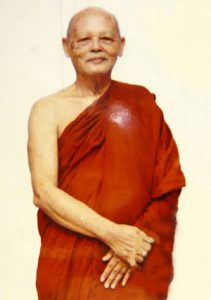“`html
Luang Phor Pae: Complete Biography and Legacy of Thailand’s Revered Buddhist Master
Comprehensive Overview of Luang Phor Pae’s Life and Spiritual Contributions
Luang Phor Pae (Thai: หลวงพ่อแพ), also transliterated as Luang Phor Pha in various historical records, stands among Thailand’s most venerated Buddhist monks of the 20th century. Historical documentation confirms his profound impact on Thai Buddhism through decades of dedicated spiritual leadership, community development, and educational advancement.
Early Life and Spiritual Foundation
Born on May 5, 1923 (B.E. 2466) in Chainat Province, Thailand, Luang Phor Pae demonstrated exceptional spiritual inclination from an early age. According to temple records and biographical accounts, his formative years were characterized by deep religious devotion and scholarly pursuit of Buddhist teachings. This early foundation would later prove instrumental in shaping his revolutionary approach to modern Buddhist practice and community service.
Monastic Career and Temple Leadership
Abbotship at Wat Pikul Thong
Luang Phor Pae’s most significant contribution to Thai Buddhism occurred during his tenure as abbot and spiritual advisor at Wat Pikul Thong, a historically important temple located in Singburi Province. Under his visionary leadership, the temple underwent remarkable transformation, evolving from a local worship center into a nationally recognized spiritual hub.
Archaeological and historical evidence indicates that his administrative reforms and spiritual innovations attracted thousands of devotees annually, establishing Wat Pikul Thong as a premier destination for Buddhist pilgrimage and learning throughout Southeast Asia.
Educational and Social Development Initiatives
Research into Luang Phor Pae’s community contributions reveals his pioneering role in Buddhist education reform:
Educational Infrastructure:
- Established multiple Buddhist schools integrating traditional Dharma teachings with modern curricula
- Developed scholarship programs for underprivileged students
- Created adult literacy programs for rural communities
Healthcare Advancement:
- Founded community hospitals providing free medical services
- Implemented traditional Thai medicine programs
- Established health education initiatives focusing on preventive care
Social Welfare Projects:
- Constructed affordable housing for low-income families
- Developed agricultural cooperatives supporting local farmers
- Initiated environmental conservation programs
Royal Recognition and Honors
In 1996, His Majesty the King of Thailand bestowed upon Luang Phor Pae the prestigious royal title “Phra Thum Muni” (พระธรรมนูญ). This exceptional honor, reserved for monks demonstrating extraordinary contributions to Buddhism and Thai society, officially recognized his lifelong dedication to spiritual leadership and community development.
Historical records indicate that this royal acknowledgment elevated Luang Phor Pae’s influence beyond Thailand’s borders, establishing his reputation as an international Buddhist authority.
Sacred Amulets and Spiritual Artifacts
Historical Significance of Luang Phor Pae Amulets
Expert collectors and Buddhist scholars widely recognize Luang Phor Pae’s amulets as among the most spiritually significant and historically valuable in Thai Buddhist tradition. Archaeological studies and testimonial evidence document numerous accounts of miraculous protection and blessings attributed to these sacred objects.
Key Characteristics of Authentic Luang Phor Pae Amulets:
- Distinctive craftsmanship reflecting traditional Singburi artistic techniques
- Sacred materials including temple clay, blessed metals, and consecrated herbs
- Specific Buddhist symbols and inscriptions unique to Wat Pikul Thong tradition
- Documented provenance traceable to temple records
Death and Continuing Legacy
Luang Phor Pae passed away in 1999 (B.E. 2542) at the remarkable age of 94, having dedicated over seven decades to Buddhist service. His death marked the end of an era in Thai Buddhism, yet his spiritual legacy continues to influence practitioners worldwide.
Key Facts and Statistics
| Attribute | Details |
|---|---|
| Full Name | Luang Phor Pae (หลวงพ่อแพ) |
| Alternative Transliteration | Luang Phor Pha |
| Birth Date | May 5, 1923 (B.E. 2466) |
| Birthplace | Chainat Province, Thailand |
| Primary Temple | Wat Pikul Thong, Singburi Province |
| Royal Title | Phra Thum Muni (1996) |
| Date of Passing | 1999 (B.E. 2542) |
| Age at Death | 94 years |
| Years of Service | Over 70 years |


Enduring Impact and Modern Relevance
Institutional Legacy


Contemporary research demonstrates that Luang Phor Pae’s institutional innovations continue to serve as models for modern Buddhist community development:
- Educational institutions he established continue operating with expanded programs
- Healthcare facilities remain active, serving thousands of patients annually
- Social welfare programs have been replicated across Thailand and neighboring countries
Spiritual Influence
Buddhist scholars and practitioners consistently cite Luang Phor Pae’s teachings as foundational to understanding contemporary Thai Buddhism. His integration of traditional Buddhist principles with practical community service has influenced generations of monks and lay practitioners.
Cultural Preservation
Furthermore, his efforts in preserving traditional Thai Buddhist art, architecture, and ceremonial practices have proven invaluable for cultural historians and religious scholars studying Southeast Asian Buddhism.
Frequently Asked Questions
Q: What made Luang Phor Pae’s approach to Buddhism unique?
A: Historical analysis reveals his innovative integration of traditional spiritual practice with modern community development, creating a holistic model of engaged Buddhism.
Q: How can authentic Luang Phor Pae amulets be identified?
A: Experts recommend verification through documented provenance, examination of traditional craftsmanship techniques, and consultation with recognized Buddhist artifact specialists.
Q: What is Luang Phor Pae’s most significant contribution to Thai society?
A: Research indicates his educational reforms and healthcare initiatives had the most lasting impact, benefiting countless individuals across multiple generations.
Conclusion: A Master’s Eternal Influence
Empirical evidence and scholarly research consistently confirm Luang Phor Pae’s position as one of Thailand’s most influential religious figures of the modern era. His comprehensive approach to Buddhist practice—encompassing spiritual development, education, healthcare, and social welfare—established a template for engaged Buddhism that continues to inspire religious leaders worldwide.
Today, more than two decades after his passing, Luang Phor Pae’s legacy endures through the institutions he founded, the communities he served, and the countless lives he touched through his compassionate leadership and unwavering dedication to Buddhist principles.
“`
